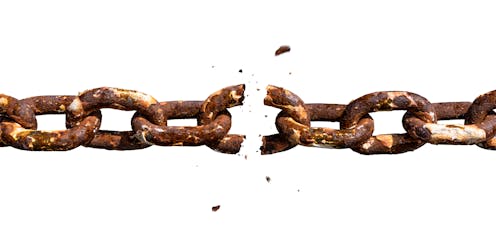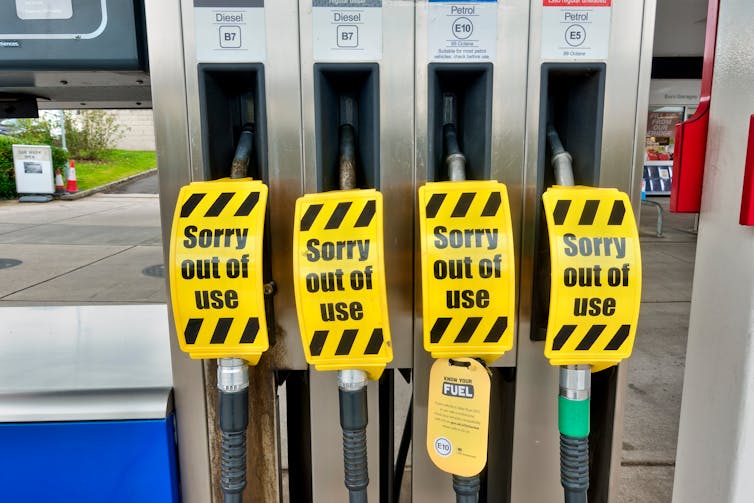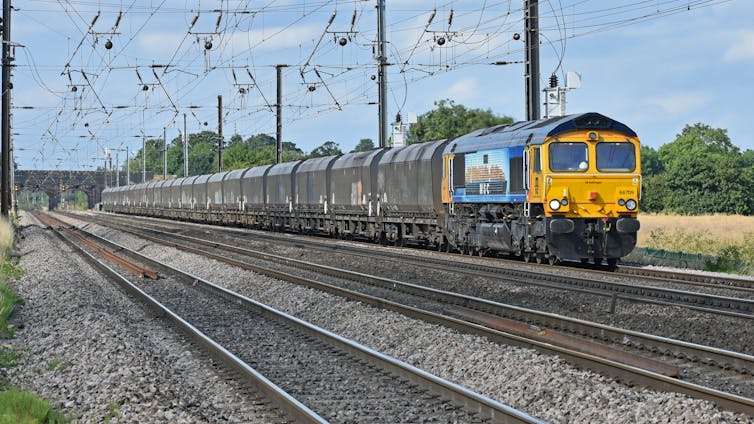Supply chains can easily break – here's how they can be made more resilient to prevent shortages
- Written by Tom Stacey, Senior Lecturer in Operations and Supply Chain Management, Anglia Ruskin University
 shutterstock
shutterstockSupply chains are essential to everyday life, bringing materials to factories, food to your plate, and fuel to your car.
The links in those chains – the manufacturers, logistics companies, warehouses and retailers – combine to form dynamic systems driven by customer demand. But a small, unpredictable change in demand can have major ramifications, as seen with the recent queues and rising tempers at petrol stations in the UK.
This is because modern supply chains are not designed to cope with large levels of uncertainly around time, supply or demand. Instead, businesses have focused on developing operations which reduce costs
But a cheaper supply chain often means a weaker supply chain. And problems arise when lean systems lack resilience and flexibility.
This was perfectly illustrated by the disruption to the fuel supply chain in the UK which started in the distribution of supplies to petrol stations. Then the temporary closure of some forecourts triggered widespread stockpiling and panic buying. This, in turn, created a surge in demand for fuel, exacerbating the original disruption.
There have been warnings that a similar situation could arise with supplies in the coming months – for everything from food and toys to Christmas trees. And it will take more than a few thousand extra lorry drivers to truly strengthen these supply chains.
That said, more lorry drivers would be a good place to start. The UK currently needs at least 90,000 people driving HGVs, a shortage which leads to longer waiting times at ports, more congestion, and more frequently empty shelves.
But the government’s plan for 5,000 three-month visas for European drivers is not going to make a huge difference (and might not even attract any, given that Europe itself needs another 400,000) Current applications to the scheme are said to total 27.
 Running on empty?Shutterstock/Andrew Harker
Running on empty?Shutterstock/Andrew HarkerLonger lasting visas would probably be more attractive to some foreign drivers, and allow them to get familiar with the road networks in the UK, and make appropriate personal arrangements. The next step to addressing the long standing shortage would be to look at improving working conditions, reviewing pay levels and even tax incentives.
A long road
Beyond driving vehicles, there are about 2.5 million people working in haulage and logistics in the UK, covering road, rail, air and water. And while that sounds like a lot, it has been estimated that around 840,000 additional workers are needed in the sector to manage growing demand.
The logistic sector has a reputation for being low paid and harsh with long hours and poor working environments. Improving that reputation would attract more young people, as would more apprenticeships and better training.
In the long term, major infrastructure changes are needed, with improvements to ports, road, rail and inland waterways. One freight train removes 43 to 76 lorries from the roads, and one freight barge can remove about 24.
But using these alternatives is restricted by a lack of network and capacity. The new high speed railway linking up London, the Midlands, the North and Scotland (HS2) will free up additional capacity on the existing railway network, to allow more freight trains to be run.
 Don’t wait for freight.Shutterstock/M Barratt
Don’t wait for freight.Shutterstock/M BarrattHigher efficiency and effectiveness in operation is also necessary, through consolidating consignments into fewer shipments to reduce cost, to reduce the number of lorries in road, to reduce damage risk, and to improve quality control.
The whole sector needs to improve its use of digital technology to automate processes and improve efficiency and productivity while reducing reliance on labour. This would make the whole industry more resilient and dynamic, and not as exposed to the effects of staff shortages.
Reliance on fragile global supply chains can be somewhat re-balanced by investing in localised production and diversification of supply. This could involve firing up an old coal power plant (albeit this is at odds with climate goals) to meet the electricity needs in the UK temporarily, or investing in domestic production of controlled environment vegetable crops (currently 69% of fresh vegetables are imported from Spain and the Netherlands). This would reduce the UK’s dependence on “risky” overseas sources of energy, food and pharmaceuticals, and transporting less food would mean fewer emissions and longer shelf life.
Away from the industrial side of things, that key element of the supply chain – the customers – need to be mindful of the way they consume goods. They need to shop responsibly and sensibly, so that the links they depend on are not put under too much strain.
If consumers get a sense that there are shortages, then panic buying ensues as it did with toilet rolls and petrol, and this causes repercussions down the supply chain. Politicians and industry leaders are often at pains to get across the message that there is enough to go round – and usually there is.
Only by taking a broader approach to improving the supply chain and logistics industry will we be able to ensure that it is fit for purpose – and that global, or even national events do not cause shortages in shops or at fuel pumps. This means an approach supported by the industry and governments working together, but also by consumers, who will need to manage their own actions and expectations.
Tom Stacey receives funding from ERDF, investigating new energy sources.
Ying Xie works for Anglia Ruskin University. She receives funding from ERDF. She is affiliated with Anglia Ruskin University and Digital Catapult.
Authors: Tom Stacey, Senior Lecturer in Operations and Supply Chain Management, Anglia Ruskin University
